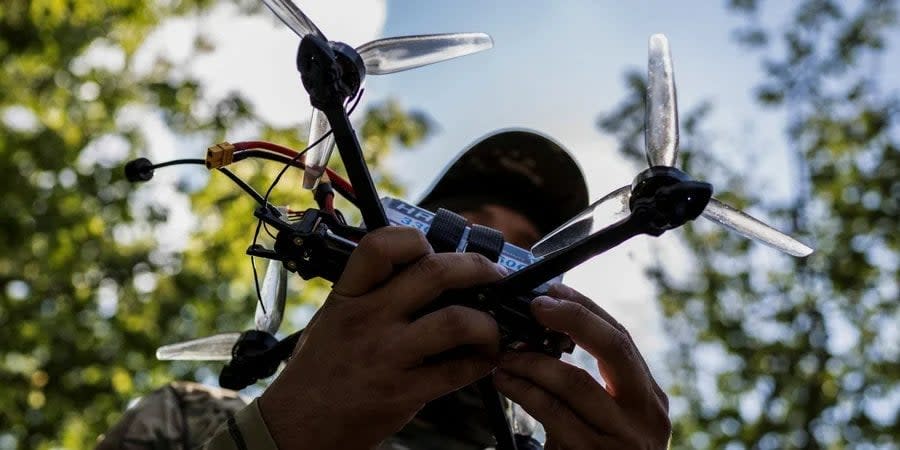Ukraine breaking through the first line of Russian defense towards Tokmak, says retired officer

- Oops!Something went wrong.Please try again later.
Retired Major Oleksiy Hetman, a veteran of the Russian-Ukrainian war, discussed the effective advance of the Ukrainian Forces in the south and the unsuccessful Russian attacks on the Kupyansk direction in an interview with Radio NV on Aug. 26.
NV: We’ll start with a statement from the chairman of the U.S. Joint Chiefs of Staff chair, General Mark Milley, who talks about Ukrainian soldiers seemingly breaking through the first line of Russian defense in Zaporizhzhya Oblast and now expanding their presence towards the strategically important city of Tokmak. Do we really see a significant change in the course of the military operations in southern Ukraine?
Hetman: There is even official information that we are already in full control of Robotyne. Take a look at the map of military operations. There's Novoprokopyvka, Solodka Balka, Ilchenkove. From this position we are around 15-18 kilometers to Tokmak now.
Read also: Zaluzhnyi convinced Ukrainian forces on verge of breakthrough — report
Tokmak is crucial on our path to Melitopol.
Around Tokmak, circular defensive structures have also been built. It’s like being encircled by a defensive ring
You can trust Mr. Milley if he says that [the Ukrainian Forces] have breached the first line [of defense] and approached the second one.
Read also: Macron hopes Ukrainian counter-offensive may restart peace talks on Kyiv's terms
Regardless of what the Russians might say, based on differing sources of information, the second, third, fifth, and subsequent lines lack the strength of the initial line. While the Russians were holding their defense along the first line, they were repositioning forces from the rear, from the second and third lines, to prevent us from making the breakthrough.
There is a sense that there will be swifter progress ahead because the defensive lines are not as formidable, and the fields are not as heavily mined, the fortifications are not as dense as they were on the first line.
NV: Your intuition is highlighted and corroborated by the Ukrainian Armed Forces Commander-in-Chief Valerii Zaluzhnyi, to U.S. officials. He mentioned that Ukrainian forces are on the brink of a breakthrough. The Wall Street Journal reported this. Additionally, according to the publication, U.S. officials debated with Ukrainians for several weeks on the best approach. American military personnel urged the Ukrainians to concentrate their efforts to attempt breaking through Russian defenses and reaching the Sea of Azov. How viable and feasible is such an idea?
Hetman: This was part of our summer offensive operation plan - to reach the shores of the Sea of Azov in order to prevent the transportation of goods to Crimea from the mainland part of Russia and also to hinder the export of anything from Crimea – to sever this artery, leaving only the Crimean Bridge, which could also be targeted by us.
Read also: Western observers failing to understand Ukrainian military tactics in counter-offensive – Friedman
As for the idea of concentrating forces in one place and conducting offensive actions, I believe that Zaluzhnyi, our General Staff, has a better understanding of how to conduct military operations, as we consistently achieve success without having an advantage in anything - neither in manpower, nor in equipment, nor in artillery, nor in aviation, especially.
Read also: Ukrainian counter-offensive likely to last for many months — Blinken
Therefore, perhaps these assumptions of our friends and partners from the United States are not bad, but it's only when such opportunities exist. And if we concentrate in one place, it's evident that it would become vulnerable to Russian ballistic and cruise missiles, artillery, and aviation. Gathering in one place to make us easier to target — it seems to me that this isn't entirely a wise tactic. We have never done so, nor do we intend to.
However, the actions we are taking are yielding results. We see progress. So, let's leave the decision-making on how to conduct offensive operations to our General Staff, rather than to our friends and advisors from other continents.
NV: Ukrainian Ground Forces Commander Colonel General Oleksandr Syrskyi visited the Kupyansk and Lyman sectors. He states the Russian forces are currently regrouping to resume their offensive in the east. But, please explain, do they have the chances and resources for that?
Hetman: They had resources before that. Because there, in Luhansk, in the northern part of our front line, they had a significant concentration — about 130,000 troops, over 500 pieces of artillery, more than 350 multiple rocket launchers, over two thousand pieces of heavy equipment, including up to a thousand tanks. Certainly, it was a powerful concentration.
A few days ago, they concentrated directly on the Kupyansk sector. They assembled around 45-50,000 personnel and the corresponding amount of everything needed for an attack. They attempted to attack, launching tank strikes. It didn't work out very well for them.
Read also: Ukraine's ‘slow’ counteroffensive could jeopardize continued US military aid – report
So it's quite possible that they will regroup, attempt to advance somewhere nearby, or bring in the forces they still have remaining there, aiming to involve around 40-45,000. We understand that mathematically, they still have 80-90,000 left, which they haven't used yet.
They might concentrate in one place and try to launch offensive operations, a breakthrough. Let them concentrate. Any concentration of forces is a vulnerable situation for the enemy, for them. If they gather a significant number of personnel and equipment in one place, then we will have targets to engage and strike at.
We’re bringing the voice of Ukraine to the world. Support us with a one-time donation, or become a Patron!
Read the original article on The New Voice of Ukraine

